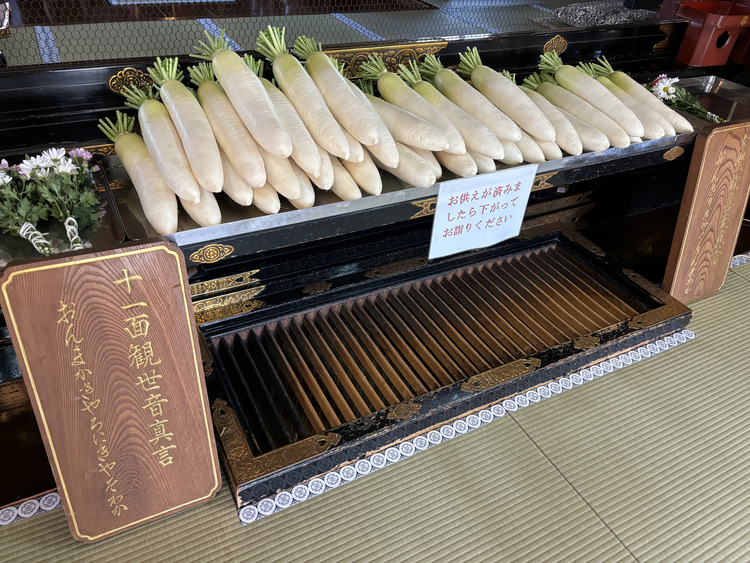ReservationSearch and reserve rooms
Click here to confirm, change or cancel your reservation
航空券付きプラン
Shinkansen accommodation plan
提携法人専用予約
2024.04.15
"Machiyuzan Honryuin" - a temple with a symbolic radish that has long been loved by Asakusa residents
NEIGHBORS

Asakusa is a town that still retains the atmosphere of Edo. It is a place with a calm streetscape that highlights the red of Sensoji Temple. As Asakusa was once the center of Edo, many shrines and temples were built here to protect the area around the castle.
The beloved Shoden of Asakusa
One of the most representative temples in Asakusa is Matsuyama Honryuin. This temple enshrines Shoden, a Buddha familiar to Asakusa. Shoden has long been revered as the most powerful god who can grant any wish. It is said that Toyotomi Hideyoshi, Tokugawa Ieyasu, and Matsushita Konosuke were all devout believers in the temple.
The symbol of Matsuchiyama Honryuin Temple, beloved by the people of Asakusa, is the rather unusual daikon radish and a pouch (a rice dumpling called Kankidan). Illustrations and decorations of daikon radishes and pouches can be seen throughout the temple.

▲At the temple, there are lanterns with radishes painted on them. The loose touch is adorable.
Why are radishes and pouches used as symbols?
Mr. Fukaya, the butler at Matsuchizan Honryuin Temple, explained the history of Matsuchizan Honryuin Temple using Japanese paintings.
"Some Japanese paintings from the Edo period depict townspeople worshiping at the temple while holding radishes, so it seems the temple has been popular as a radish temple since ancient times. The Buddha is so familiar to Asakusa that there was even a town called Shoten-cho up until the Showa period. Even today, many worshippers come to pay their respects at the Daikon Festival, held at the beginning of the year, and the temple has become a deeply rooted festival in Asakusa."
First of all, you may be wondering why the radish and the pouch became the symbols. According to Mr. Fukaya, the reason is due to the characteristics of Shoden.
"The radish and the pouch-shaped rice dumplings are possessions of Shoden. Radish is spicy, so when you eat it, you frown. It is said that the radish symbolizes human anger because of that expression. The pouch-shaped rice dumplings are sweet, so they are said to represent human dependency and desire."
Matsuchiyama Honryuin Temple also sells radishes to offer to the Buddha. By offering radishes along with your offering, you can let go of your anger and desires and make a wish.

▲A mountain of radishes offered. The offerings from the previous day were distributed as hand-me-downs.
The main hall is a sacred space that will cleanse your soul.
Matsuchiyama Honryuin is a temple where you can enter the main hall and pray indoors. The main hall is decorated with glittering ornaments, and the ceiling is decorated with Japanese paintings of dragons and heavenly maidens, creating a sacred atmosphere. If you pray under the watchful eye of the Buddha, you can escape the hustle and bustle of everyday life and spend a peaceful time.
"We also lend out sutra desks, and you can see people reciting sutras," says Fukaya happily.

▲A Japanese painting of a dragon associated with the temple's Kinryuzan mountain. It was created by a Showa-era Japanese painter called Katayama Nanpu.
Inside the main hall, there are products on display, including daikon drawstring charms with daikon radishes on them, Shusse Kannon charms, and goshuincho (stamp books). You can also purchase a collection of ukiyo-e paintings of Asakusa and Matsuchiyama Honryuin Temple in the Edo period, sutras, prayer beads, and goshuin (stamps).

▲There is also a drawstring bag-shaped charm with a radish design, which makes use of the motif symbolizing Matsuchiyama Honryuin Temple.
Matsuchiyama Honryuin Temple is one of the scenic spots that has been loved since the Edo period. It has been depicted in many Japanese paintings, and is said to be the place where the famous Katsushika Hokusai chose to spend his final days.
Today, you can see the quietly flowing Sumida River and the Skytree towering into the blue sky, creating a typical Asakusa scene where you can feel the unchanging atmosphere of the Edo period and modern technology.

Taste the radish that symbolizes the beloved Shoden in Asakusa
After offering daikon radish at Matsuchiyama Honryuin Temple, head to a restaurant where you can enjoy dishes made with daikon radish. At Gohan x Cafe Madei, located just a one-minute walk from Matsuchiyama Honryuin Temple, you can enjoy a matchmaking set meal featuring daikon radish. The main dish is a stew of fish and daikon radish. The miso soup and salad also contain daikon radish, making this a set meal where you can enjoy plenty of daikon radish.

Matsuchiyama Honryuin has been loved by Asakusa residents since the Edo period. It is a place where you can offer daikon radishes, pray slowly and spend a peaceful time. After praying, you can eat daikon dishes and purify your body and mind, which will help you spend the day feeling refreshed.

待乳山本龍院
電話番号:03-3874-2030
住所:東京都台東区浅草7-4-1
アクセス:東京メトロ銀座線浅草駅から徒歩11分
HP:http://www.matsuchiyama.jp/
※営業時間や定休日についての詳細は上記のリンク先にてご確認ください。




